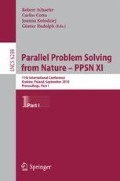Abstract
In Lässig and Sudholt (GECCO 2010) the first running time analysis of a non-trivial parallel evolutionary algorithm was presented. It was demonstrated for a constructed function that an island model with migration can drastically outperform both panmictic EAs as well as parallel EAs without migration. This work provides additional empirical results that increase our understanding of why and when migration is essential for this function. We provide empirical evidence complementing the theoretical results, investigate the robustness with respect to the choice of the migration interval and compare various migration topologies using statistical tests.
The authors were supported by postdoctoral fellowships from the German Academic Exchange Service.
Access this chapter
Tax calculation will be finalised at checkout
Purchases are for personal use only
Preview
Unable to display preview. Download preview PDF.
References
Alba, E.: Parallel evolutionary algorithms can achieve super-linear performance. Information Processing Letters 82(1), 7–13 (2002)
He, J., Yao, X.: Analysis of scalable parallel evolutionary algorithms. In: Proceedings of CEC 2006, pp. 120–127 (2006)
Cantú-Paz, E., Goldberg, D.E.: On the scalability of parallel genetic algorithms. Evolutionary Computation 7(4), 429–449 (1999)
Tomassini, M.: Spatially Structured Evolutionary Algorithms: Artificial Evolution in Space and Time. Springer, Heidelberg (2005)
Skolicki, Z., De Jong, K.: The influence of migration sizes and intervals on island models. In: Proceedings of GECCO 2005, pp. 1295–1302. ACM, New York (2005)
Lässig, J., Sudholt, D.: The benefit of migration in parallel evolutionary algorithms. In: Proceedings of GECCO 2010, pp. 1105–1112. ACM, New York (2010)
Wineberg, M., Christensen, S.: Statistical analysis for evolutionary computation: introduction. In: Companion of GECCO 2009, pp. 2949–2976. ACM, New York (2009)
Author information
Authors and Affiliations
Editor information
Editors and Affiliations
Rights and permissions
Copyright information
© 2010 Springer-Verlag Berlin Heidelberg
About this paper
Cite this paper
Lässig, J., Sudholt, D. (2010). Experimental Supplements to the Theoretical Analysis of Migration in the Island Model. In: Schaefer, R., Cotta, C., Kołodziej, J., Rudolph, G. (eds) Parallel Problem Solving from Nature, PPSN XI. PPSN 2010. Lecture Notes in Computer Science, vol 6238. Springer, Berlin, Heidelberg. https://doi.org/10.1007/978-3-642-15844-5_23
Download citation
DOI: https://doi.org/10.1007/978-3-642-15844-5_23
Publisher Name: Springer, Berlin, Heidelberg
Print ISBN: 978-3-642-15843-8
Online ISBN: 978-3-642-15844-5
eBook Packages: Computer ScienceComputer Science (R0)

